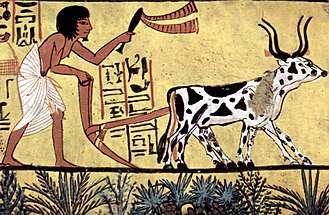Small-scale agriculture
Small-scale agriculture has been practiced ever since the Neolithic Revolution. More recently it is an alternative to factory farming or more broadly, intensive agriculture or unsustainable farming methods that are prevalent in primarily first world countries. Environmental Health Perspectives has noted that "Sustainable agriculture is not merely a package of prescribed methods. More important, it is a change in mind set whereby agriculture acknowledges its dependence on a finite natural resource base--including the finite quality of fossil fuel energy that is now a critical component of conventional farming systems." [1]
| Agriculture |
|---|
 |
|
Categories
|
|
|
Small-scale agriculture includes a number of sustainable agriculture practices such as:
- organic farming, which may follow rules and regulations set by International Federation of Organic Agriculture Movements (IFOAM)
- permaculture, which provides a holistic methodology for farm design
- arable land use, arable land (from Latin arare, to plough ) is a form of agricultural land use, meaning land that can be (and is) used for growing crops. David Ricardo incorporated the idea of arable land into economic theory.
- non-arable land use
- pastoral, pastoral refers to the lifestyle of shepherds and pastoralists, moving livestock around larger areas of land according to seasons and availability of water and feed.
- rainfed agriculture
- biodynamic agriculture was developed by Rudolf Steiner, which consists of using herbal and homeopathic preparations for the cow dung/manure that is used extensively on the crops for fertilizer.
The methods of food sustainability and economics are hotly debated. This is a question between agricultural economics and the draining of the largely unaccounted natural capital.
Productivity
Small farms have many economic advantages. Local farmers generate a local economy in their rural communities. An American study showed that small farms with incomes of $100,000 or less spend almost 95 percent of their farm-related expenses within their local communities. The same study took in comparison the fact that farms with incomes greater than $900,000 spend less than 20 percent of their farm-related expenses in the local economy.[2] Thus, small-scale agriculture supports local economy.
Agricultural productivity is variously measured, and large-scale farming is often less efficient than small sustainable farms. Industrial single crop creates a high output per worker whilst, small-scale farmers produce more food per acre of land.[3]
Small-scale agriculture often sell products directly to the consumers. Disintermediation gives the farmer the profit that would otherwise go to the wholesaler, the distributor and the supermarket. About two thirds of the selling price would actually be lost for product marketing. Meanwhile, if farmers sell their products directly to consumers, they recover the totality of their product value.[4]
See also
- Family farm
- Compassion In World Farming
- Agroecology
- Agribusiness
- Corporate farming
- Contract farming
- rotational grazing
- Subsistence farming
- Smallholder agriculture
- Convertible husbandry
- Green Revolution
- Intensive farming
References
- Horrigan, Leo (2002). "How Sustainable Agriculture Can Address the Environmental and Human Health Harms of Industrial Agriculture". Environmental Health Perspectives. 110 (5): 454. doi:10.1289/ehp.02110445. PMC 1240832. PMID 12003747.
- Chism, J.W.; Levins, R.A. (1994). "Farm". Minnesota Agricultural Economist. Spring 1994 (676).
- Gorelick, Steven; Norberg-Hodge, Helen (2002). Bringing the Food Economy Home: Local Alternatives to Global Agribusiness. Kumarian Press (US). Retrieved 5 November 2014.
- Fortier, Jean-Martin (2012). Le jardinier maraîcher. Canada: Écosociété. ISBN 978-2-89719-003-3.